Question 1
The graph shows the variation with time of the displacement of an electromagnetic wave at a point. The wave is travelling in a vacuum.
The wave is travelling in a vacuum.
What is the amplitude and what is the wavelength of the wave?
| amplitude/arbitrary units | wavelength/m | |
|---|---|---|
| A | 3.0 | 6000 |
| B | 6.0 | 6000 |
| C | 3.0 | 7500 |
| D | 6.0 | 7500 |
Medium
Mark as Complete
Mark Scheme
Question 2
Determine the wavelength and amplitude of each of the two waves shown in figure.
Easy
Mark as Complete
Mark Scheme
Question 3
The intensity of light from a small lamp is inversely proportional to the square of the distance of the observer from the lamp, that is `I ∝ 1/r^2`
Observer A is 1.0 m from the lamp; observer B is 4.0 m from the lamp. Calculate how the amplitudes of the light waves received by the two observers compare.
Medium
Mark as Complete
Mark Scheme
Question 4
In figure, the time period T is 2 s and the time t is 0.25 s. Calculate the phase difference between the two waves in degrees. 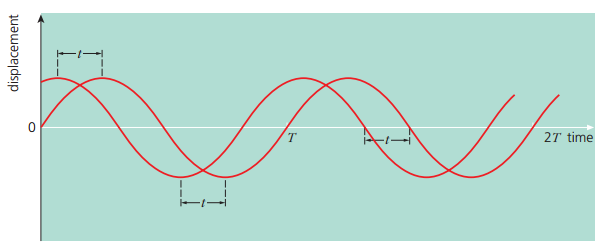
Easy
Mark as Complete
Mark Scheme
Question 5
The time-base setting for the CRO used to obtain the trace in figure is 2.0 ms.cm-1. Determine for the sound:
a. The time period.
b. The frequency.
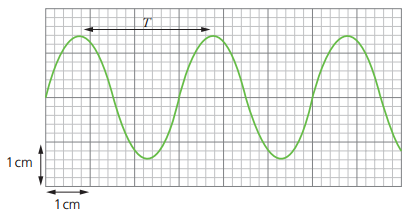
Easy
Mark as Complete
Mark Scheme
Question 6
Figure represents the displacement against distance for a transverse wave. Which point, A, B, C or D vibrates out of phase with point O by 180°?
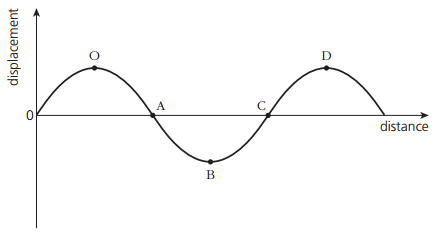
Easy
Mark as Complete
Mark Scheme
Question 7
A student is studying a water wave in which all the wavefronts are parallel to one another. The variation with time t of the displacement x of a particular particle in the wave is shown in figure 1.
Figure 1:
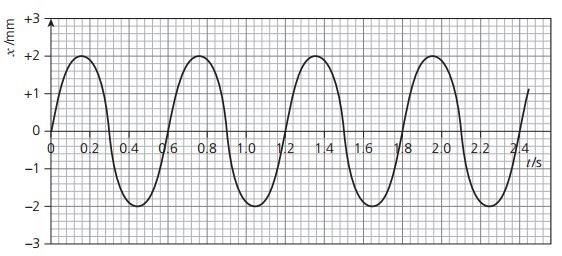 The distance d of the oscillating particles from the source of the waves is measured. At a particular time, the variation of the displacement x with this distance d is shown in figure 2.
The distance d of the oscillating particles from the source of the waves is measured. At a particular time, the variation of the displacement x with this distance d is shown in figure 2.
Figure 2:
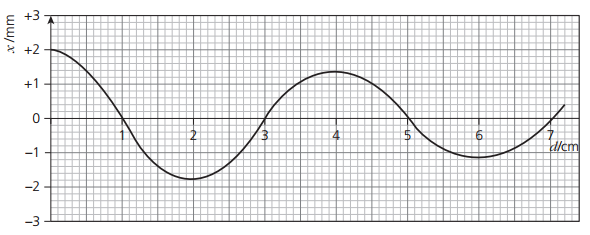 a. Use Figure 1 and 2 to determine, for the water wave:
a. Use Figure 1 and 2 to determine, for the water wave:
i. The period T of vibration.
ii. The wavelength λ.
iii. The speed v.
b.
i. Use Figure 1 and 2 to state and explain whether the wave is losing power as it moves away from the source.
ii. Determine the ratio `"intensity of wave at source"/"intensity of wave 6.0 cm from source"`
Hard
Mark as Complete
Mark Scheme
Question 8
A microphone connected to the Y-plates of a cathode-ray oscilloscope (CRO) is placed in front of a loudspeaker. The trace on the screen of the CRO is shown.
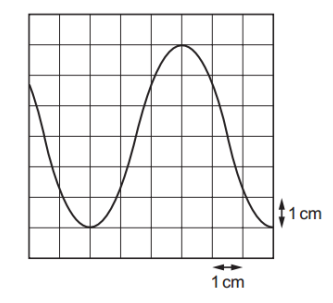
The time-base setting is 0.5 ms.cm⁻¹ and the Y-plate sensitivity is 0.2 mV.cm⁻¹.
What is the frequency of the sound from the loudspeaker and what is the amplitude of the trace on the CRO?
| frequency/Hz | amplitude/mV | |
|---|---|---|
| A | 330 | 0.6 |
| B | 330 | 1.2 |
| C | 670 | 0.6 |
| D | 670 | 1.2 |
Medium
Mark as Complete
Mark Scheme
Question 9
A progressive wave travels from left to right along a stretched string. Figure shows part of the string at one instant.

P, Q, and R are three different points on the string. The distance between P and R is 0.48 m. The wave has a period of 0.020 s.
a. Use figure to determine the wavelength of the wave.
b. Calculate the speed of the wave.
c. Determine the phase difference between points Q and R.
Hard
Mark as Complete
Mark Scheme
Question 10
Which statement is correct for all types of progressive wave?
A. The distance from a peak to the next trough is equal to a wavelength.
B. They can be demonstrated in ripple tanks.
C. They consist of vibrating atoms.
D. They transfer energy from one position to another.
Medium
Mark as Complete
Mark Scheme
Question 1
The graph shows the variation with time of the displacement of an electromagnetic wave at a point. The wave is travelling in a vacuum.
The wave is travelling in a vacuum.
What is the amplitude and what is the wavelength of the wave?
| amplitude/arbitrary units | wavelength/m | |
|---|---|---|
| A | 3.0 | 6000 |
| B | 6.0 | 6000 |
| C | 3.0 | 7500 |
| D | 6.0 | 7500 |
Answer: A Amplitude = 3 arbitrary units
Amplitude = 3 arbitrary units
`"Wavelength" = "speed"xx"period" = 3.0 xx 10^8 xx 20 xx 10^-6 = "6000 m"`
Question 2
Determine the wavelength and amplitude of each of the two waves shown in figure.
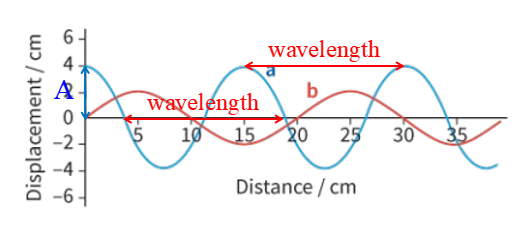 a. Wavelength 15 cm, amplitude 4 cm.
a. Wavelength 15 cm, amplitude 4 cm.
b. Wavelength 20 cm, amplitude 2 cm.
Question 3
The intensity of light from a small lamp is inversely proportional to the square of the distance of the observer from the lamp, that is `I ∝ 1/r^2`
Observer A is 1.0 m from the lamp; observer B is 4.0 m from the lamp. Calculate how the amplitudes of the light waves received by the two observers compare.
Intensity of light at B: `(1/4)^2 = 1/16` of that at A.
`I_B = (1/4)^2 = 1/16 I_A`
Since intensity is proportional to the square of amplitude: `I ∝ A^2`
Therefore, `A ∝ sqrt(I)`
Amplitude at B is: `A_B = sqrt(1/16) = 1/4 A_A`
Hence, the amplitude at B is one-quarter the amplitude at A
Question 4
In figure, the time period T is 2 s and the time t is 0.25 s. Calculate the phase difference between the two waves in degrees. 
The fraction of time t to the period T is `t/T = 0.25/2 = 0.125`
Hence the phase difference is `0.125 xx 360 = 45^@`
Question 5
The time-base setting for the CRO used to obtain the trace in figure is 2.0 ms.cm-1. Determine for the sound:
a. The time period.
b. The frequency.

a The distance for a time period is 3.0 cm.
Hence the period `T = 3.0 xx 2.0 xx 10^-3 = 6.0 xx 10^-3 " s"`
b. The frequency is `f = 1 / T = 1 / (6.0 xx 10^-3) = "170 Hz"`
Question 6
Figure represents the displacement against distance for a transverse wave. Which point, A, B, C or D vibrates out of phase with point O by 180°?

In a transverse wave, two points are said to be 180° out of phase if they are at opposite displacements and are separated by half a wavelength.
Point O is at the maximum positive displacement.
The point that is furthest down (maximum negative displacement) in the wave is point B.
This means point B is 180° out of phase with point O.
Question 7
A student is studying a water wave in which all the wavefronts are parallel to one another. The variation with time t of the displacement x of a particular particle in the wave is shown in figure 1.
Figure 1:
 The distance d of the oscillating particles from the source of the waves is measured. At a particular time, the variation of the displacement x with this distance d is shown in figure 2.
The distance d of the oscillating particles from the source of the waves is measured. At a particular time, the variation of the displacement x with this distance d is shown in figure 2.
Figure 2:
 a. Use Figure 1 and 2 to determine, for the water wave:
a. Use Figure 1 and 2 to determine, for the water wave:
i. The period T of vibration.
ii. The wavelength λ.
iii. The speed v.
b.
i. Use Figure 1 and 2 to state and explain whether the wave is losing power as it moves away from the source.
ii. Determine the ratio `"intensity of wave at source"/"intensity of wave 6.0 cm from source"`
a.
i. From figure 1, one complete oscillation (wave cycle) occurs in 0.6 s. so T = 0.6 s.
ii. From figure 2, one full wave (peak to peak) spans from 0 cm to 4 cm, so λ = 4 cm = 0.04 m
iii. `v = lambda / T = 0.040 / 0.60 = 0.067 " m.s"^-1`
b.
i. Since amplitude decreases with distance, the wave is losing power as it moves away.
ii. use the proportionality: Intensity ∝ (Amplitude)²
`"Intensity ratio" = (2.0)^2 / (1.1)^2 = 4 / 1.21 approx 3.3`
Question 8
A microphone connected to the Y-plates of a cathode-ray oscilloscope (CRO) is placed in front of a loudspeaker. The trace on the screen of the CRO is shown.

The time-base setting is 0.5 ms.cm⁻¹ and the Y-plate sensitivity is 0.2 mV.cm⁻¹.
What is the frequency of the sound from the loudspeaker and what is the amplitude of the trace on the CRO?
| frequency/Hz | amplitude/mV | |
|---|---|---|
| A | 330 | 0.6 |
| B | 330 | 1.2 |
| C | 670 | 0.6 |
| D | 670 | 1.2 |
Answer: A
From the CRO trace, one full wave cycle (from one peak to the next peak) spans 3 cm horizontally.
Given:
Time-base setting = 0.5 ms.cm-1
`"Period T" = "6 cm" × 0.5" ms"."cm"^-1 = "3 ms"`
`f = 1 / T = 1 / (3 xx 10^-3) = "333.33 Hz" ≈ "330 Hz"`
From the trace, the peak (amplitude) spans 3 vertical divisions.
Given:
Y-sensitivity = 0.2 mV.cm-1
`A = "3 cm" xx 0.2" mV"."cm"^-1 = "0.6 mV"`
Question 9
A progressive wave travels from left to right along a stretched string. Figure shows part of the string at one instant.

P, Q, and R are three different points on the string. The distance between P and R is 0.48 m. The wave has a period of 0.020 s.
a. Use figure to determine the wavelength of the wave.
b. Calculate the speed of the wave.
c. Determine the phase difference between points Q and R.
a. From the diagram, we can observe that the distance from point P to point R spans 1.5 wavelengths.
`1.5 lambda = "0.48 m "=> lambda = "0.32 m"`
b. `v = lambda / T = 0.32 / 0.020 = 16 " " "m"."s"^-1`
c. From the graph:
Point Q is λ/4 away from point P.
Point R is 1.5λ away from point P.
So the distance between Q and R is `1.5 lambda - 0.25 lambda = 1.25 lambda`
The phase difference: `Delta phi = 1.25 xx 360^@ = 450^@`
Question 10
Which statement is correct for all types of progressive wave?
A. The distance from a peak to the next trough is equal to a wavelength.
B. They can be demonstrated in ripple tanks.
C. They consist of vibrating atoms.
D. They transfer energy from one position to another.
Answer: D
A. Incorrect: The distance from a peak to the next trough is actually half a wavelength, not a full wavelength.
B. Incorrect: While water waves (a type of progressive wave) can be shown in a ripple tank, not all progressive waves can. For example, sound waves and light waves cannot be demonstrated this way. So this is not universal.
C. Incorrect: This applies to mechanical waves like sound waves, but electromagnetic waves (like light, X-rays, etc.) do not involve atoms at all.
D. Correct: This is the defining characteristic of a progressive wave (or traveling wave): it transfers energy through a medium without transferring matter.
Question 1
The graph shows the variation with time of the displacement of an electromagnetic wave at a point. The wave is travelling in a vacuum.
The wave is travelling in a vacuum.
What is the amplitude and what is the wavelength of the wave?
| amplitude/arbitrary units | wavelength/m | |
|---|---|---|
| A | 3.0 | 6000 |
| B | 6.0 | 6000 |
| C | 3.0 | 7500 |
| D | 6.0 | 7500 |
Question 2
Determine the wavelength and amplitude of each of the two waves shown in figure.
Question 3
The intensity of light from a small lamp is inversely proportional to the square of the distance of the observer from the lamp, that is `I ∝ 1/r^2`
Observer A is 1.0 m from the lamp; observer B is 4.0 m from the lamp. Calculate how the amplitudes of the light waves received by the two observers compare.
Question 4
In figure, the time period T is 2 s and the time t is 0.25 s. Calculate the phase difference between the two waves in degrees. 
Question 5
The time-base setting for the CRO used to obtain the trace in figure is 2.0 ms.cm-1. Determine for the sound:
a. The time period.
b. The frequency.

Question 6
Figure represents the displacement against distance for a transverse wave. Which point, A, B, C or D vibrates out of phase with point O by 180°?

Question 7
A student is studying a water wave in which all the wavefronts are parallel to one another. The variation with time t of the displacement x of a particular particle in the wave is shown in figure 1.
Figure 1:
 The distance d of the oscillating particles from the source of the waves is measured. At a particular time, the variation of the displacement x with this distance d is shown in figure 2.
The distance d of the oscillating particles from the source of the waves is measured. At a particular time, the variation of the displacement x with this distance d is shown in figure 2.
Figure 2:
 a. Use Figure 1 and 2 to determine, for the water wave:
a. Use Figure 1 and 2 to determine, for the water wave:
i. The period T of vibration.
ii. The wavelength λ.
iii. The speed v.
b.
i. Use Figure 1 and 2 to state and explain whether the wave is losing power as it moves away from the source.
ii. Determine the ratio `"intensity of wave at source"/"intensity of wave 6.0 cm from source"`
Question 8
A microphone connected to the Y-plates of a cathode-ray oscilloscope (CRO) is placed in front of a loudspeaker. The trace on the screen of the CRO is shown.

The time-base setting is 0.5 ms.cm⁻¹ and the Y-plate sensitivity is 0.2 mV.cm⁻¹.
What is the frequency of the sound from the loudspeaker and what is the amplitude of the trace on the CRO?
| frequency/Hz | amplitude/mV | |
|---|---|---|
| A | 330 | 0.6 |
| B | 330 | 1.2 |
| C | 670 | 0.6 |
| D | 670 | 1.2 |
Question 9
A progressive wave travels from left to right along a stretched string. Figure shows part of the string at one instant.

P, Q, and R are three different points on the string. The distance between P and R is 0.48 m. The wave has a period of 0.020 s.
a. Use figure to determine the wavelength of the wave.
b. Calculate the speed of the wave.
c. Determine the phase difference between points Q and R.
Question 10
Which statement is correct for all types of progressive wave?
A. The distance from a peak to the next trough is equal to a wavelength.
B. They can be demonstrated in ripple tanks.
C. They consist of vibrating atoms.
D. They transfer energy from one position to another.